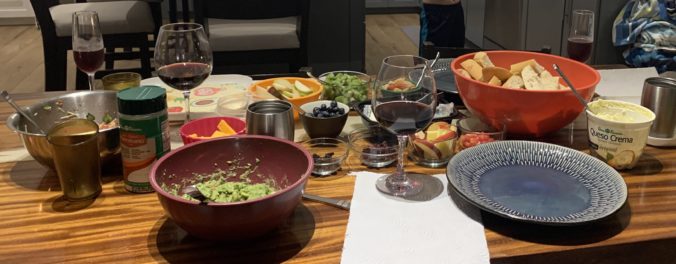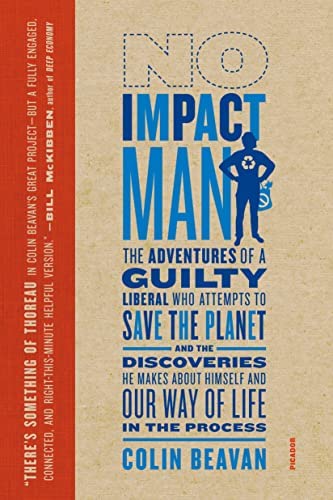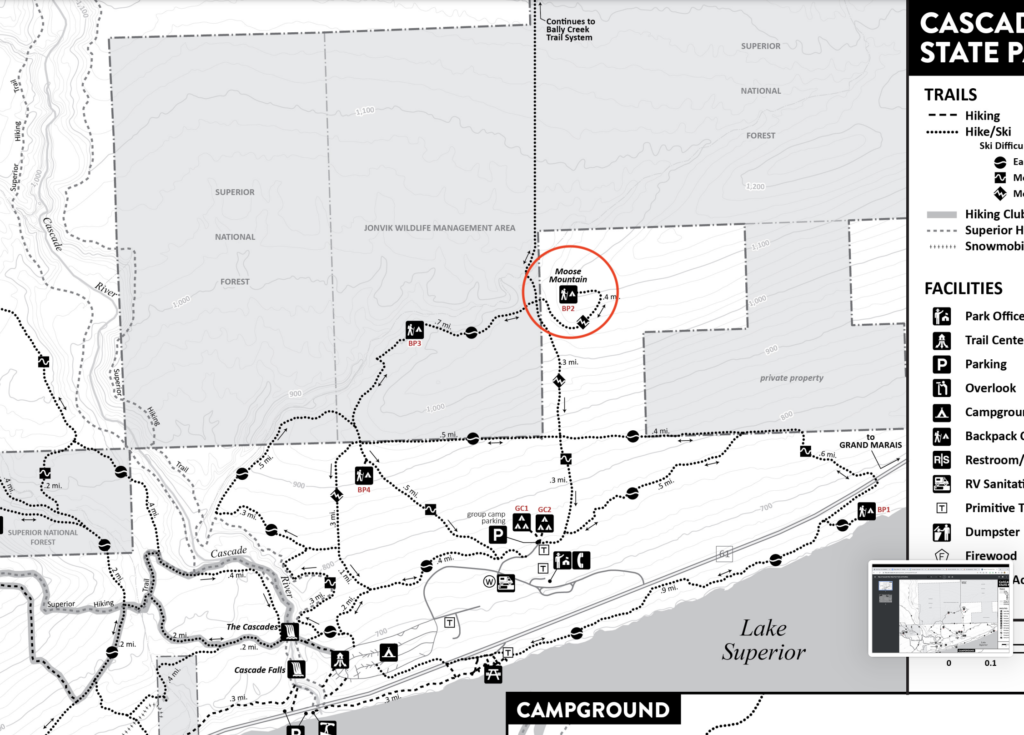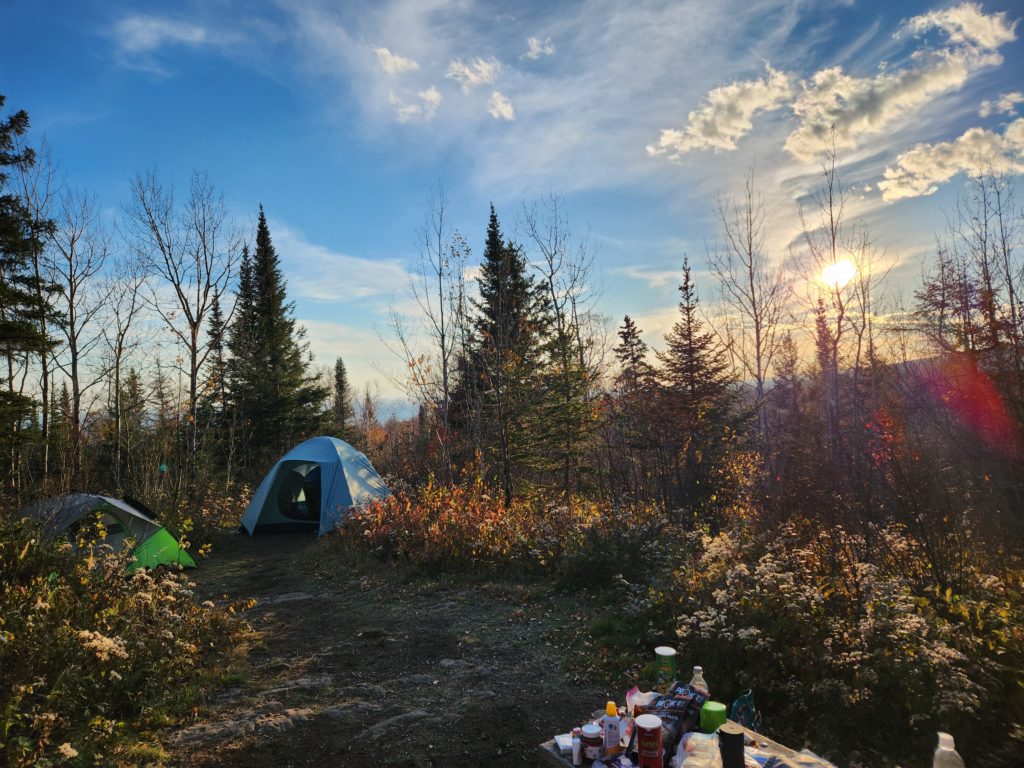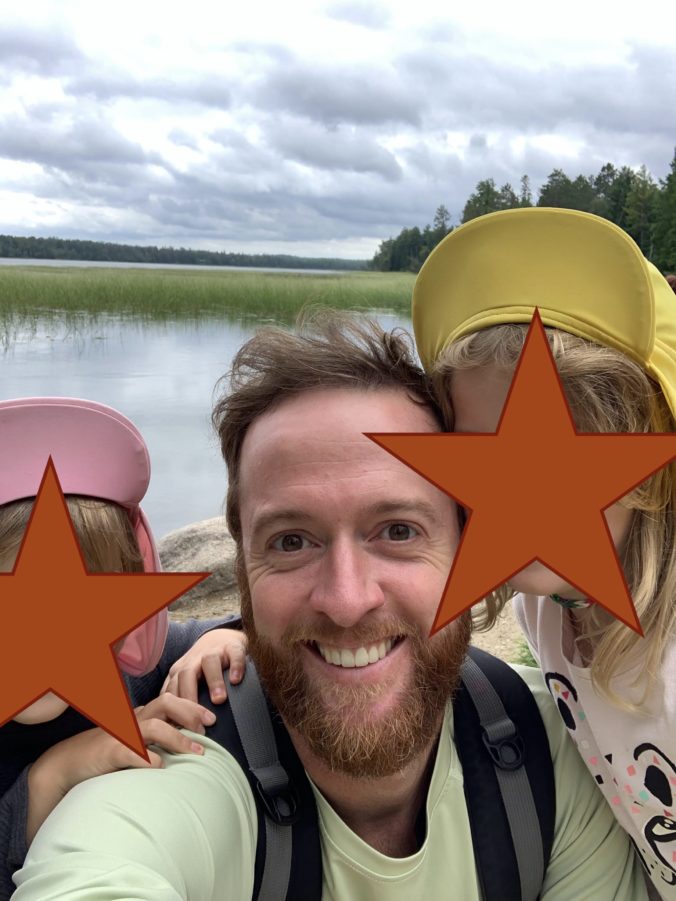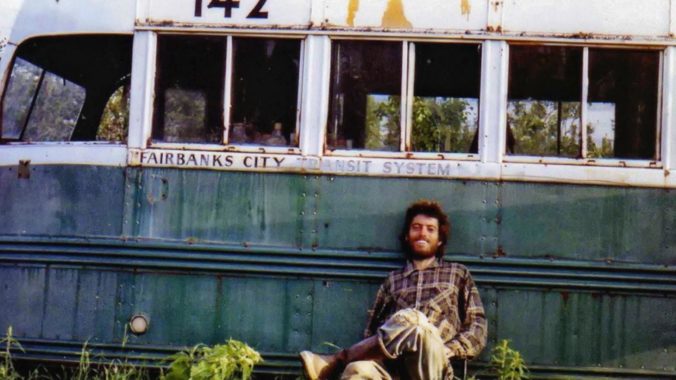Months ago, I planned and booked a camping trip for our family to Itasca State Park. I had done a three-night solo camping trip there in September 2021, and at that time I had assessed that it would be an excellent state park to bring the entire family. So as soon as it became available to reserve, I booked us a campsite (with a camper cabin, a one-room log cabin to add a touch of convenience) for the end of August 2022. As the day of departure approached, Kristyn began to develop a cold, and I suggested that perhaps I could take the kids camping and she could stay home to rest and enjoy some alone time. This offer did not take much convincing. And so, the kids and I loaded up in the minivan and embarked upon a four-night camping trip, just the three of us.
Even though my kids are only six and four years old, and even though we were going to be three and a half hours from home, and even though I was not going to have any help in taking care of my children nor myself, I was feeling confident about the adventure. Excited. A touch of nervousness, perhaps, but having completed a successful two-night camping trip with my eldest earlier in the summer, and having spent so much time with both kids all summer long and observed their current maturity levels, I felt like we were just on the right edge of being “old enough” to make this a viable endeavor with me as the only parent. Thanks to the awesomeness of my children, I couldn’t have been more right.
Here’s an excerpt from my journal on the night of arrival to our campsite (and let’s just reflect on the fact that I had even one moment to consider writing in a journal!):
The girls have chosen to use the markers and paper we brought to color while sitting on the floor. “Amar Pelos Dois” is cooing over the portable speaker in our nicer-than-expected camper cabin. Four nights in a cabin with my two kids – it feels a bit like ‘The Ultimate Survival Challenge,’ but it also feels like it’ll be a cinch. It’s the second hour of being here, and the girls are showing me they can occupy themselves and each other, even with rain bringing us inside. … This time in the woods with my kids is the last hurrah before summer is over and the final school year in the USA starts. What is my intention with this time? To demonstrate to my kids that fun and joy can be had without much. To experience hiking in a positive way (my youngest is not a huge fan, yet). To let them lead so we all can learn from their choices and behaviors.
We had a lovely spaghetti dinner. I cleaned up while they played Concentration with each other. We began a tradition of enjoying tea and apples after dishes were done. And for the next three days, we enjoyed exploring, hiking, playing, finding bear tracks, picking M&M’s out of trail mix, swimming, and simply being in the outdoors.
MY CHILDREN ARE MORE GROWN THAN I KNOW
When taken into the outdoors, without many modern conveniences and left to their own devices, they seemed to age two years in two minutes. All of a sudden, not only did my youngest child no longer need or want any help in a public bathroom (the family bathroom kind where it’s just one small room), they specifically requested I leave them be and wait outside. Both kids, all of a sudden, seemed to just know how to wash and dry dishes, when given the opportunity. When we arrived at the headwaters of the Mississippi River, the main attraction of Itasca State park, the kids did not hesitate. You see, at these headwaters of America’s largest and most powerful river, the river is very small, almost streamlike. There are rocks that act as stepping stones where one can actually hop across the Mighty Mississippi. It’s not the most challenging physical act, to balance on these rocks and make it across, but it’s also more challenging than taking a stroll on a sidewalk. And when my kids saw this, saw a few adults carefully making their way across the stones, my kids did not hesitate. As I wrote in my journal later, “Before I knew it, their shoes were off. Fording the Mississippi with two children… it was mildly stressful, but I was simultaneously proud and in awe of their bravery and ability/balance, while enjoying the experience for myself.” It blew me away how ready and equipped they already are to act more mature, and all it took was removing distractions, removing convenience, giving them an opportunity to shine, and then getting out of their way.
MEETING THE COLDWATER’S
One afternoon, we were hanging out at the park’s largest playground, the one near the swimming beach, and it was here that we had what felt to me like a fateful encounter. It was here that we met the Coldwater family, a family of three that live “off the grid,” as they put it, in northern Minnesota. The woman and her son were playing at the park, speaking French to each other (I learned the woman is from Belgium) and at this my children’s ears perked up, because they are learning Spanish and have an ear for foreign language. This curiosity about their language was enough to spark interaction with these people, and the more I learned about the Coldwater family’s life, the more I was drawn in. They built their own house using natural materials like straw, wood, and lime plaster. They are acquiring a sailboat and have plans to sail from the Caribbean, through the Saint Lawrence seaway, all the way to Lake Superior to return to their home in northern Minnesota. They also plan to take this boat on a Trans-Atlantic voyage to the Mediterranean for a couple of years. They have no running water and bring water from the natural spring that’s 1/4 mile away from their home, 2-3 times every day. They have intimate knowledge of how to harvest and prepare wild rice, a practice they learned from the Lakota people. I could go on. Oh, and they were just delightful human beings who seemed completely in tune with enjoying the present moment. I was and still am so enchanted with this family. I don’t necessarily aspire to live in a log cabin off the grid, but I do believe they are living in a way that is much more connected to the natural world, the world from which we all come, than I am, and for that, I admire them. I deeply hope to stay connected to them in some way, but if not, I’m happy to have met and to have been inspired by them. And I am grateful that I listened to my kids and let them lead the way when they said, “We want to go to the park,” or I would have never met the Coldwater family.
A FEW FINAL MEMORIES OF SOLO CAMPING WITH TWO KIDS
- When you arrive to the state park and your campsite isn’t ready yet, head straight for the playground.
- A quick backstory – when I was a kid, I remember eating apples after dinner, but before bed. We would do this often in my home (via my dad), and we would do it even more often whenever I was visiting my grandparents (my dad’s parents). While I still enjoy apples, eating them nightly is not a habit I carried forward into my own life. Fast forward to this camping trip, and as I packed for it, I brought precisely enough apples with us so that we could share an apple together every night. Not sure why, it just felt right. Every night, as I placed a bowl of sliced apples on the cabin table in front of my children, I could feel some historical, inter-generational frequency vibrating within me. Like, even though I haven’t actually been there before, it felt like I had been there before. Almost like I could feel my father and his father working through me. And I was aware of the feeling like I am actively passing on a tradition, a conscious programming of my children to share some of the same programming etched into my core. I did not plan for nor expect this feeling to arise, but it was really cool when it did.
- At one point, the kids were using the toys that I had brought in ways I would never have imagined – they were outside, using the jump rope and ladder golf ladders, and other items from nature to construct a sort of… bridge structure. At one point, in between the gathering and placing of sticks, rocks, and pinecones on top of this structure, my kid looked to me and said, “We know that water is the glue of nature, so we’re going inside to get our water bottles.”
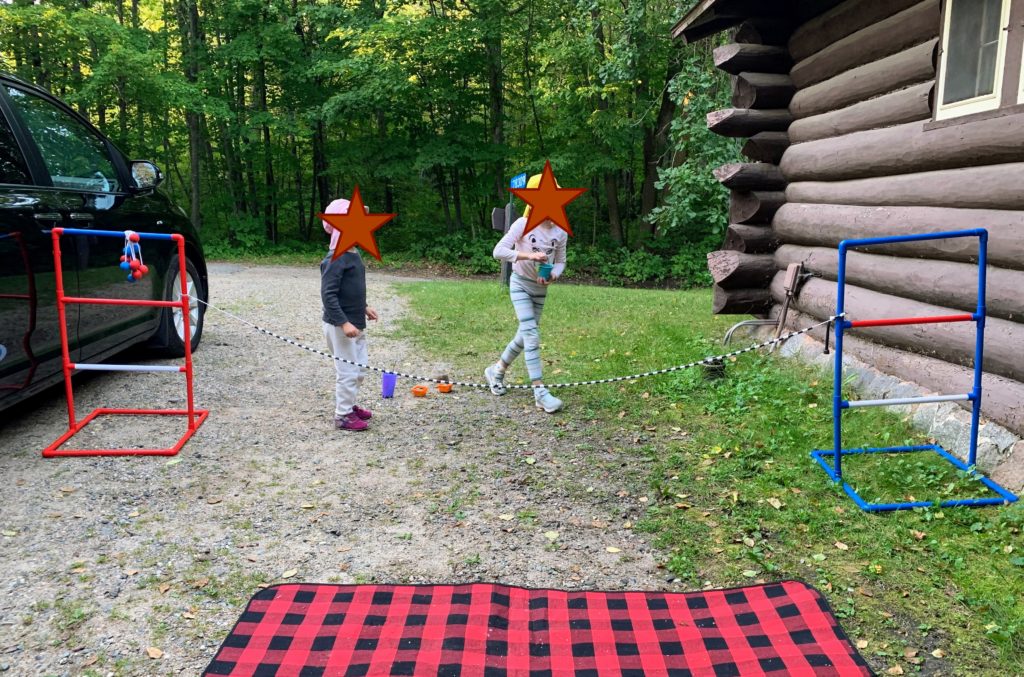
Building a bridge together
MORE FUN OUTSIDE AND FINDING INSPIRATION EVERYWHERE
Our camping trip was from Sunday-Thursday, so when we got home, we still had the weekend to enjoy, and although one might think we would have been depleted of energy from the time outdoors and the long car ride, it was quite the contrary – we all felt energized from living a more simple life and spending time together. So, we went out for some more activity!
The day after we returned from camping, the weather was gorgeous and Kristyn was still not feeling 100%, so I took the kids to a park in town. They simply could not get enough of being outside! I felt proud at how easily they made friends with other kids at the beach. As they played with newly-made friends, I went for a nearby stroll, and I happened to notice this dedication placard on one of the park benches. It reads: “Jerry Gale [In Honor Of]. High-energy dad, grandpa, & eternal optimist who went to bat for causes he believed in.” I don’t know who Jerry Gale is, but I know he must have been a great man. If, once I pass away, my family remembers me in this way, I will consider my life a success.

An inspiration
THAT’S A WRAP ON SUMMER – WHAT HAVE I LEARNED FROM ALL THIS TIME WITH MY KIDS?
The end of this week marks a wrap on summer. A sabbatical summer. I spent so much time with my kids, intentionally so. Earlier in the season, I consciously made the choice that this summer was going to be a time of me being a kid again, of letting go of what’s “supposed” to happen. So, what did I learn from my two little sources of wisdom?
- We are social creatures. My kids love making friends with anyone. It’s a credit to their friendly personality and disposition, and it’s also their plain humanity shining through. Their “flow state” is enabled when playing with or talking to new humans.
- What does that look like in the adult world? How do I suppress my natural urges to connect with a new person? Why do I do that? What do I fear? What would it look like if I gave all strangers the same benefit of the doubt that my kids give other children on the playground?
- Siblings are extremely valuable. My kids practice so many life skills together: communication, problem solving, teamwork, debate… They don’t really realize how lucky they are to have each other.
- This makes me more grateful for my own brother. Even though we don’t talk much these days, I’m very grateful we had each other in our formative years. I believe I’m a better person because I had him (and my parents) around to teach me the kind of things an older brother needs to be taught: humility, thinking of others, sharing, and so on.
- Parenting is easier when I let go of personal wants. In spending heaping amounts of time with my children, moments of my impatience or frustration inevitably arose. When I examine the root cause of those moments, they almost all originate from having my own desire. I want to finish the chapter in my book. I want to go on a long hike. I want to start making progress on preparing dinner. I want, I want, I want. Whenever I have a want that doesn’t align with my kid’s want, friction occurs.
- If my goal is for parenting to be easier, and for my relationship with my child to grow positively, there is a simple answer – let go of my want. It fixes everything.
- My kids simply want me to be with them. During the day. At night. They seem to not be able to get enough of me, of my attention, of my love, of my energy. They want me to be their witness. Their cheerleader. To be there in case something bad happens. To have someone to read to them. Someone to snuggle. Or climb on. Someone to play pretend with. To hold the heavy things. Someone to help. Sure, they’re getting old enough to be able to play on their own for a while and enjoy it, but it’s never their first choice. I am not this great to anyone else on the planet.
- For two people to have this much pure love of me, I owe them my energy and my time.
